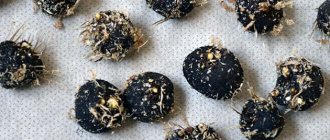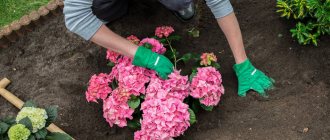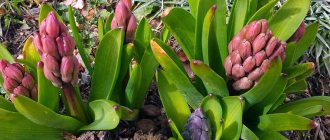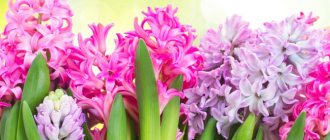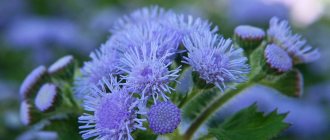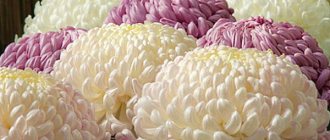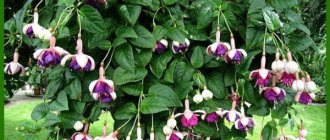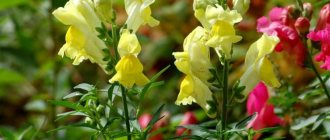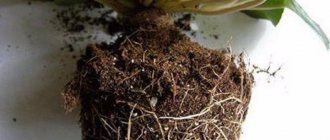Syrian tree hibiscus is also known as garden hibiscus. It looks like a fairly compact shrub, about 3 meters high. The inflorescences are saucer-like, flowering begins in the second half of summer to the beginning of autumn. The inflorescences are ordinary, sometimes double. The color is pink, white, red. The frost-resistant hibiscus plant can withstand temperatures down to -25 degrees. But for good abundant flowering, constant warm weather is necessary. Hibiscus prefers a sunny place and grows well in neutral soil.
Description of Syrian tree hibiscus
Syrian hibiscus (Hibiscus) is a plant from the Malvaceae family; its second name is garden (street) rose or Sharon. Syrian hibiscus (you will see the photo below) is a tree-like shrub with a height of 2 to 6 meters, depending on the variety. The stem is thick, has a tree-like shape, the branches are erect, not branching.
The flower has green, ovoid, medium-sized leaves with jagged edges. Hibiscus blooms with beautiful single simple and double flowers. Flowers can be of different colors: from white to crimson, sometimes bicolor.
A photo in the garden with this exotic plant looks great. Although hibiscus grows slowly, many gardeners strive to grow it.
A distinctive feature characteristic of many varieties of garden hibiscus is the late flowering time, which occurs from the end of July to October inclusive. This feature and the exotic appearance of the flowers have contributed to the fact that this plant has become a real miracle of the passing summer in many gardens and household plots. Quite common among gardeners is the tree hibiscus. Photos of this beautiful plant can be seen in many gardening websites and magazines.
Quite large flowers that form on the shoots of the current year can be double, half-double, simple, with petals wavy at the edges, two-color or plain, with an eye of a contrasting color. All this depends on the plant variety.
To get a beautiful hibiscus in the garden, it is important to carefully prepare for planting it. It is necessary to purchase good seedlings of this plant and choose the right place on the site for planting. Care should also be taken to properly prepare the soil for this luxurious exotic miracle of nature.
Distinctive features and varieties
In central Russia, the most widespread is the Syrian rose - hibiscus, which is distinguished by its winter hardiness and ease of cultivation. This unpretentious flower loves warmth and light, but is afraid of excessive humidity and drafts.
Swamp hibiscus: planting and care in open ground
Flowering period - late July-early September. A large number of flower buds are formed. And, despite the fact that the lifespan of the bud is one day, wilting is not noticeable, and the appearance of the plant does not deteriorate.
Important! Indoors, it is optimal to grow “guest from Syria” on windows facing south. In the summer, he will be glad to move to the balcony, closer to the sun and natural light.
In the gardens of the Urals and central Russia, the deciduous shrub grows up to 1.5-2 m in height. The flowers reach 7-12 cm in diameter and can be one-color or two-color.
The most popular types:
- Hybrid (garden, herbaceous). Obtained in the mid-20th century. Winter-hardy, straight-trunked. From the ground to the top it reaches 1-1.7 m. The buds are 12 cm in diameter and bright pink. The foliage is emerald-amber. May be annual.
- Youth. A weakly branched bush up to 1.5 m high. It is distinguished by the yellow-malachite color of the shoots growing at an angle of 60°, and by snow-white flowers 10 cm in diameter, shaped like a tulip.
- Late. A compact shrub measuring 1x1 m. Leaves with whitish veins and jagged tips fit tightly to each other. Among others, they stand out for their oval arrow-shaped shape, low pedicels and narrow bell-shaped inflorescences of raspberry-pinkish and lilac tones with a volume of 7 cm.
- Pale pink. Height 170 cm. The shoots are small, located at an angle of 60°. Serrated yellow-green cut foliage. The buds are 12 cm in circumference in the form of a tulip with a white bottom and pink “walls”.
- Pink-porcelain reaches a height of 130 cm. The bush has amber-green branched long stems and deeply incised leaves (6 cm), as well as pale pink rosettes resembling bells with barely visible yellowness and a boiling white pharynx with a diameter of 12 cm. The inflorescences are united in brushes on a low stalk.
- Indoor, or Chinese rose. Bred for greenhouses, gardens, rock gardens and rose gardens. Breeding in a home microclimate and greenhouses will also be optimal. Blooms all year round.
- Bolotny. These are large flowers 12 cm in diameter. Looks great as a hedge.
- Sour. Another name for annual maple. The bush is characterized by wedge-shaped carved leaves and red petals. It fits harmoniously into landscape design as an independent element, and is also used to build a living fence.
Note! When purchasing a seedling for open ground, a sprout with non-double petals would be preferable as it is more frost-resistant.
Diseases and pests of garden hibiscus
Hibiscus, despite its exotic status, copes well with typical threats and rarely gets sick. Problems in its development are often associated not with diseases, but with improper feeding and care in general. So, for example, the falling of leaves, especially active at the bottom of the crown, occurs due to salinization of the soil, and the lack of flowering is only due to excess nitrogen. Fungal infections are not scary for hibiscus, but soil depletion, waterlogging, active drafts, and lack of mulch are critical factors.
Pests threaten hibiscus in the garden only when adjacent to infected plants. Aphids, thrips, and whiteflies especially love tubs and potted hibiscus, and spider mites are very common. It is better to fight any insects immediately with insecticides. True, we should not forget about correcting the care that caused the vulnerability - in particular, measures to humidify the air.
The bark of a hibiscus, covered for the winter with spruce branches without burlap, can attract rodents, in particular voles. To avoid an unpleasant visit and damage to the plant, set traps or place some anti-rodent preparations around the hill. If you used burlap in addition to spruce branches, then such measures will not be needed.
Syrian hibiscus, variety 'Oiseau Bleu'. © fiori-forchette
Varieties of Syrian rose
Breeders have developed many species that differ in color, flower shape, height and bushiness. Herbaceous hibiscus has the largest flower stalks - up to 40 cm in diameter, can withstand frosts down to minus 30 degrees, so it overwinters well without shelter in the middle zone. It is characterized by accelerated growth - in one summer the plant can reach a height of 3 m with proper care and feeding.
Swamp hibiscus flowers are smaller - up to 18 cm in diameter, but this plant is not afraid of high groundwater and can grow in lowlands, where puddles collect in spring and autumn. There are about 200 species of swamp hibiscus, and some compact varieties can be grown indoors. Although considered an evergreen shrub, leaf fall is observed at temperatures below 10 degrees.
The shape of the peduncle with a long stamen resembles an indoor Chinese rose.
- Hibiscus Syrian Blue Chiffon is a variety whose main feature is the color of its flowers. This variety is often called “chiffon” because of the tenderness of its petals. Blue chiffon attracts attention, because in nature the blue color, clear and pure, practically does not occur with a transition to blue.
- Hibiscus Syrian Oziau blue. This variety also has blue flowers, but their central color is red.
- Hibiscus Syrian Matilda is memorable with a red spot on the pink petals of the flower.
- It is no coincidence that the Syrian Red Heart hibiscus is called “red heart”: the central part of its white flowers is red in color.
- Hibiscus Syrian Ardens is distinguished not only by the compactness of the bush, but also by its flowers. Each double flower is purple in color.
- Hibiscus Syrian Duc de Brabant is equally good both in the form of a bush and in the form of a tree, colored with purple and red petals.
Blue Chiffon
A light-loving variety with small leaf blades and small flowers of a beautiful blue hue.
It is moderately drought-resistant and tolerant of slight temperature drops.
Application in landscape design
The Syrian rose is a wonderful garden decoration. As I like to say, quoting a classic, this is “a holiday that is always with you.”
Hibiscus is an excellent tapeworm; it can be planted in the most visible place - in the center of a flower bed, in the patio, at the entrance to the house. Fits well into various compositions with thujas, spruces and other conifers. When planting hibiscus for a hedge, do not forget that it grows quite quickly and the distance between plants should be at least 1 m.
Hibiscus Duc de Brabant has a beautiful proportional crown with a height of about 1.2 m. In early - mid-July every year a small miracle occurs - the hibiscus blooms. Flowering continues for a long time, somewhere until the end of September, and its peak occurs at the end of July. At this time, the entire bush is covered with flowers - an extraordinary sight! Try planting it in your garden, you won’t regret it.
Brief description of cultivation
- Landing. In spring, from mid to late May.
- Bloom. From the last days of June to the beginning of October.
- Illumination. Sunny areas are suitable.
- Priming. The soil should be nutritious, light and well drained. Hibiscus can be grown in areas where roses grow well.
- Watering. It is necessary to water systematically, especially on hot days, but do this only when the soil dries out. During the dry season, watering is carried out every day.
- Trimming. In early spring, before sap flow begins, rejuvenating, sanitary and formative pruning is carried out.
- Fertilizer. Hibiscus should be fed from June to September once every 2 weeks; for this purpose, mineral fertilizers with a high content of nitrogen and phosphorus are used. In autumn, potassium fertilizer should also be added to the complex.
- Reproduction. By cuttings, grafting, layering and seed method.
- Harmful insects. Thrips, spider mites, aphids and whiteflies.
- Diseases. Root rot and chlorosis.
Growing Syrian hibiscus in the garden
Syrian hibiscus bushes are very dense and are not afraid of pruning the crown. They can be used to form hedges or landscape compositions.
Of course, our latitudes are a foreign land for exotics. To successfully grow it, you must follow a number of rules.
Main rules for growing:
- correct choice of landing site;
- regular abundant watering;
- feeding;
- preparing bushes for winter.
As for caring for Syrian hibiscus, this includes protection from pests, disease prevention and regular pruning of the crown.
Planting scheme
Plants are planted according to a certain pattern. The first step is to prepare a hole, the size of which should be twice as large as the root system of the bush. A layer of drainage is laid on the pits, which should be approximately fifteen centimeters thick. You can use broken bricks for this. Then a ten-centimeter layer of sand is laid, a 15-centimeter layer of compost, and again a layer of sand. The soil that was removed from the hole is mixed with peat and sand in a ratio of 2:4:1. Next, the seedling is carefully placed in a recess at a shallow depth and covered with soil. The root collar should be slightly sprinkled with soil.
After planting, the plant should be hilled up and watered abundantly. When the moisture is absorbed, a small depression will form, which should be sprinkled with the remaining soil to level the area.
Initially, you need to keep the soil slightly moist around the bush, especially at times when it is too hot or dry. It follows that the plant requires regular watering. After the flower takes root and begins to bloom, watering may become less intense. It is also better not to allow it to dry out, because this will cause the buds to dry out, and then they will fall off and because of this the shrub will lose its original attractive appearance. If the weather outside is not hot, then watering is carried out approximately once every two weeks.
Benefits of planting hibiscus Duc de Brabant
This charming plant is ideal for the garden for the following reasons:
- Long flowering - the bush is covered with flowers throughout the summer.
- Tall growth - the plant is used in compositions where there is a need to include large flowering plants.
- Easy care - just choose a sunny, quiet place for the hibiscus, nutritious soil without soaking, and the plant will immediately show all its beauty.
- Easy transplanting - seedlings from containers are transplanted easily and quickly take root.
| Boarding time | March – May August. - October |
| Height | 150 – 200 cm. Bush width 150 cm |
| Distance | 200 – 300 cm |
| Landing location | Sun. light partial shade |
| Frost resistance | minus 28°C |
| Property | the most spectacular and impressive variety with lacy inflorescences |
| Flowering time | July – JulyJuly. - September |
| Application | used to create hedges and deciduous compositions. in flower beds and even containers |
Growing indoor hibiscus at home
Hibiscus is quite hardy and not particularly demanding when growing indoors. It grows quite quickly. With good care, it blooms profusely; it happens that it blooms even during the winter dormant period.
It is better to place it in a place protected from drafts, but well lit. It is necessary to fertilize periodically: throughout the entire growing season, mineral fertilizer (10 g per 10 l) is added to the water for irrigation approximately once every two weeks. In early spring, simultaneously with replanting, the plants are pruned, which promotes better branching.
Hibiscus propagation
Hibiscus propagates by cuttings and seeds.
Seeds
Sowing takes place from mid-January to mid-March. Before planting, the seeds should be soaked in epin for 12 hours, and then sown in a mixture of sand and peat. The planting container must be covered with glass, the temperature maintained at 25-27°C and periodically opened for ventilation. As the seedlings develop 2-3 leaves, it is necessary to dive into pots of the appropriate size. Flowering and fruiting of hibiscus grown from seeds occurs in the 3-4th year of planting. As roots appear, the sprouts need to be planted in indoor pots and watered well.
Step-by-step procedure for planting seeds:
- The seeds are soaked in a growth stimulant.
- 1 seed is planted in a special substrate in separate containers (cups).
- When sowing in spacious containers, sprouts must be picked after the appearance of 1 - 2 leaves.
- Seedlings are kept in a warm, bright place.
- When 6–7 leaves appear, the seedlings begin to bush; it is necessary to pinch the tops of the shoots.
- The seedlings are transplanted into new separate containers for growth using the transshipment method.
- Regular watering and fertilization.
- Next spring, the stronger plants are planted in open ground.
Cuttings
On tree-like species, cuttings are cut and the lower leaves are removed. After treatment with a root former, they are buried in peat, diluted by a third with perlite. After watering, the container is covered with film. At temperatures above +21°C, roots appear within a month. At this moment, the seedlings are pinched and planted in the ground.
Some gardeners believe that it is better to plant new hibiscus in pots and keep them indoors until next spring.
Reproduction by dividing the bush
How it's done:
- After the snow melts, as soon as the ground thaws, dig up a 3-4 year old bush.
- Using a knife or sharp shovel, divide the rhizome at the rate of: 1 trunk - 1 separate specimen.
- Dip the cuts in wood ash or crushed coal.
- Planting material cannot be stored for a long time; it must be immediately planted in a well-watered planting hole filled with a nutrient mixture.
- Cover the rhizomes with soil, compact them, and water again.
- After half a month, feed with nitrogen fertilizer.
If everything is done correctly, new shoots will soon appear and the plant will begin to actively develop. It will bloom this summer.
How to grow from seeds and cuttings?
Even a novice gardener can propagate Syrian hibiscus Blue Chiffon. For this, seeds and cuttings are most often used.
Cuttings
Step-by-step instruction:
- In July, prepare cuttings; to do this, cut strong, young shoots with 2-3 internodes from an adult bush.
- Treat the lower cut with Kornevin or any other similar product.
- Fill the box or container with peat soil mixture and stick the cuttings into it.
- Build an impromptu greenhouse by covering the container with the shoots with thick film.
- After 4 weeks, roots form on the cuttings, after which they must be planted in separate containers. To do this, you need to prepare a nutrient substrate from sand, peat, leaf and turf soil, mixing the components in a ratio of 1:1:1:1.
- Water young flowers regularly, and when they grow and become stronger, plant them in open ground.
Seed planting method
To propagate hibiscus by seeds in open ground, you need to prepare seedlings. Step-by-step algorithm:
- Place the seed material in a dark pink solution of potassium permanganate for 30 minutes.
- After this, immerse it in the Epin solution; it should only lightly cover the seeds.
- Fill the container with a mixture of sand and peat, and then plant the material.
- Cover it with glass and put it in a warm place.
- Once a day, ventilate the plantings and remove condensation, water as the soil dries.
- After the seedlings produce their first true leaves, plant them in separate pots.
- In mid-May, move them to open ground.
Hibiscus in the house
Hibiscus or Chinese rose will help restore normal family relationships. This flower smoothes out tensions between son-in-law and mother-in-law, parents and children.
Drinking tea together near a blooming Chinese rose will resolve even a protracted conflict, help restore mutual understanding and establish a friendly atmosphere in the house.
It is recommended to have hibiscus in every home. It is believed that they have positive energy and attract good spirits to the house. This flower also has a positive effect on physical and mental activity.
In addition to all its beneficial properties, hibiscus also cleanses and improves indoor air. And weak plants growing near hibiscus begin to feel better.
Benefits of the plant
Despite the fact that hibiscus is more familiar as an ornamental plant, the calyxes of its flowers are widely used to prepare hibiscus tea, which not only has a tonic property, but also has beneficial health properties. When brewed with boiling water and left to steep for a few minutes, the result is a bright red, sour-tasting, pleasant drink. Dry calyxes of flowers in hot water increase several times and release a large amount of vitamins and minerals into the drink. This tea is useful for strengthening the immune system and preventing colds. In addition, it has such positive effects on the body as:
- cleanses the liver and kidneys, gives a diuretic and bactericidal effect;
- reduces nervous excitability, fights insomnia;
- when chilled, lowers blood pressure,
- strengthens the walls of blood vessels;
- stimulates metabolism;
- helps burn fat.
Usually brew 1-2 teaspoons of boiling water per glass of water and leave for 5 minutes. Another way to prepare a healthy drink is to steep the flowers in cold water for a few minutes and boil for 2-3 minutes. It is better to use ceramic or glass containers for brewing, since hibiscus flowers contain citric acid, and in metal containers the tea may darken and lose many of its beneficial properties and taste.
The hibiscus flower is associated with the belief that it brings love, happiness and prosperity to the home. It is worth getting yourself a pet that will please the eye, lift your spirits and give you useful flowers for a health drink.
Questions - answers
Is caring for Syrian hibiscus too difficult?
Hibiscus is an unpretentious and unpretentious plant. It does not require special maintenance conditions; a novice gardener can handle it quite well.
Frost resistance, which varieties require shelter for the winter?
In regions with cold winters, shelter construction requires all varieties of Syrian rose.
How bright and sunny should the lighting be?
The brighter the place for planting the Syrian rose is illuminated, the brighter and more abundant its flowering will be. Light shading is allowed during the midday heat, but in the morning and evening hours the plant should receive direct sunlight.
What colors can be combined with in the garden?
There is an excellent combination of hibiscus with almost any variety of roses. In addition, in appearance they will form a luxurious tandem. If you live in a fairly warm region, then plant several lavender bushes next to the hibiscus - this will not only give the garden aesthetic appeal, but will also protect the hibiscus from various pests.
Why doesn't Syrian hibiscus bloom?
If you planted a hibiscus in a bright, spacious area and care for it, as required by agricultural technology, but it nevertheless does not want to bloom, most likely the problem is a lack of phosphorus and boron. And if the shoots slow down their growth, then the problem is also a lack of nitrogen. Don’t forget to apply the fertilizers your hibiscus needs on time, and it will definitely bloom.
Why do the leaves turn yellow?
Hibiscus leaves turn yellow due to chlorosis, as well as in case of injury to the root system that the plant could receive during transplantation. If the hibiscus turns yellow due to the roots, then it is necessary to add Zircon or Kornevin to the water for irrigation (see instructions) and for spraying the leaves (three drops per half liter of water). Hibiscus leaves turn yellow as a result of insufficient watering during the hot, dry summer.
Why do the leaves fall?
If hibiscus leaves fall off in the fall, this is a natural process, but if this happens prematurely, then the problem arose either due to improper watering (insufficient or excessive), or the root of the plant is injured. For recommendations on what to do in these cases, see the previous sections.
